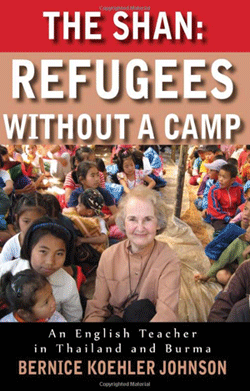Blackboard Memories
A teacher finds fulfillment at a school for young Shan refugees
Bernice Koehler Johnson discovered Burma and its problems late in life. The American teacher was nearly 70 when she applied for a job teaching Shan refugees in Thailand.
Johnson had already taught in more than half a dozen countries around the world, and Thailand promised to be just one more on her teaching itinerary. “I liked adding new countries to the list,” she confessed.
 |
| The Shan: Refugees Without a Camp, by Bernice Koehler Johnson. Trinity-Matrix, New Jersey, 2009. P250. |
Her job in Thailand, however, took hold of her like no other. It wasn’t so much Thailand or Burma that captured her heart but her Shan pupils—“bright-eyed young people who looked not at all like the ragged refugees I had imagined.”
From them, she learned about the human rights abuses that had caused their families to flee. Her students’ harrowing accounts of atrocities committed by the Burmese army—including the gang rape of a young Shan girl—fueled an anger that smoulders throughout the book.
Johnson developed a deep rapport with her Shan students, who returned her dedication with respect and even love. One former student, a girl whose classroom work was rewarded with a job with a nongovernmental organization, wrote to Johnson: “I miss you so much. Wherever you are, whatever you do, I will always miss you.”
One student called her “mother,” while another assured the American woman who had devoted so much time to his education that he would look after her in her old age.
There can’t be many teachers in the world who receive such testimonials from their students.
Johnson left her home in the US to teach at the School for Youth from Shan State in northern Thailand and was welcomed there by a “girl dressed in blue jeans and a T-shirt”—the founder and director, Charm Tong.
She watched with pleasure as Charm Tong matured into an energetic human rights campaigner, winning international fame and awards.
“Remembering the 20-year-old girl in blue jeans I met in 2002, I chuckle,” she writes. “It’s the kind of chuckle I might emit in front of a Burmese military general, if I were bold enough, the kind of chuckle that means ‘Ha, ha, this young woman whose parents feared for her safety under your murderous regime, this young woman who grew up in an orphanage, has achieved more than you have!’”
Johnson spent Christmas 2005 with Charm Tong in the orphanage that had been the young campaigner’s early home. That was the year Charm Tong was named an “Asian Hero” by Time magazine and was nominated for the Nobel Peace Prize.
Charm Tong is the best known name in a “Where are they now?” chapter profiling the students Johnson has taught. They included two young women who were sent to the US to represent Shan State at a Denver peace conference; and a young man working in the health and safety department of a nongovernmental agency, investigating the often appalling conditions under which Shan workers toil.
“When I met these young people in 2002, they were frightened and discouraged,” writes Johnson. “Accustomed to hunger and deprivation, they had little hope for a future they could not imagine.
“Thinking about them now, I wonder if ever young people have accomplished so much under such difficult circumstances.”
Acknowledging that young Shan people in Thailand are helped by NGO training programs and individual benefactors, Johnson says that, nevertheless, “it is they, my former students themselves, who accepted each tiny seed of opportunity and germinated it with desire and compassion, until they had created abundant gardens of possibility.”
Johnson’s book is a touching tribute to a people she came to love and admire because of their resilience and strength of character in the face of unrelieved hardship and official indifference.
If its pages sometimes read like a blog, with passages of inconsequential detail—particularly describing travels through Shan State—the book is nonetheless disarmingly frank and well written and of undoubted interest to anybody touched by the plight of Burma’s ethnic minorities.
